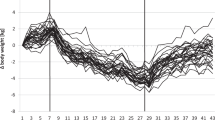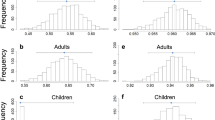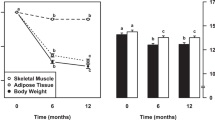Abstract
Background:
The relationship between body composition, energy expenditure and ad libitum energy intake (EI) has rarely been examined under conditions that allow any interplay between these variables to be disclosed.
Objective:
The present study examined the relationships between body composition, energy expenditure and EI under controlled laboratory conditions in which the energy density and macronutrient content of the diet varied freely as a function of food choice.
Methods:
Fifty-nine subjects (30 men: mean body mass index=26.7±4.0 kg m−2; 29 women: mean body mass index=25.4±3.5 kg m−2) completed a 14-day stay in a residential feeding behaviour suite. During days 1 and 2, subjects consumed a fixed diet designed to maintain energy balance. On days 3–14, food intake was covertly measured in subjects who had ad libitum access to a wide variety of foods typical of their normal diets. Resting metabolic rate (RMR; respiratory exchange), total daily energy expenditure (doubly labelled water) and body composition (total body water estimated from deuterium dilution) were measured on days 3–14.
Results:
Hierarchical multiple regression indicated that after controlling for age and sex, both fat-free mass (FFM; P<0.001) and RMR (P<0.001) predicted daily EI. However, a mediation model using path analysis indicated that the effect of FFM (and fat mass) on EI was fully mediated by RMR (P<0.001).
Conclusions:
These data indicate that RMR is a strong determinant of EI under controlled laboratory conditions where food choice is allowed to freely vary and subjects are close to energy balance. Therefore, the conventional adipocentric model of appetite control should be revised to reflect the influence of RMR.
This is a preview of subscription content, access via your institution
Access options
Subscribe to this journal
Receive 12 print issues and online access
$259.00 per year
only $21.58 per issue
Buy this article
- Purchase on Springer Link
- Instant access to full article PDF
Prices may be subject to local taxes which are calculated during checkout



Similar content being viewed by others
References
Stubbs R, O'Reilly L. Carbohydrate and fat metabolism, appetite and feeding behavior in humans. In: Berthoud H, Seeley R (eds). Neural and Metabolic Control of Macronutrient Intake. CRC Press: London, UK, 2000. pp 165–188.
Mayer J . Glucostatic mechanism of regulation of food intake. N Engl J Med 1953; 249: 13.
Flatt J . The difference in the storage capacities for carbohydrate and for fat, and its implications in the regulation of body weight. Ann NY Acad Sci 1987; 499: 104–123.
Kennedy G . The role of depot fat in the hypothalamic control of food intake in the rat. Proc R Soc London Ser B Biol Sci 1953; 140: 578.
Woods SC, Ramsay DS . Food intake, metabolism and homeostasis. Physiol Behav 2011; 104: 4–7.
Zhang Y, Proenca R, Maffei M, Barone M, Leopold L, Friedman J . Positional cloning of the mouse obese gene and its human homologue. Nature 1994; 372: 425–432.
Kennedy G . The hypothalamus and obesity. Proc R Soc Med 1966; 59: 1276.
Finucane M., Stevens GA, Cowan MJ, Danaei G, Lin JK, Paciorek CJ, Singh GM et al. National, regional, and global trends in body-mass index since 1980: systematic analysis of health examination surveys and epidemiological studies with 960 country-years and 9.1 million participants. Lancet 2011; 377: 557–567.
Ng M, Fleming T, Robinson M, Thomson B, Graetz N, Margono C et al. Global, regional, and national prevalence of overweight and obesity in children and adults during 1980-2013: a systematic analysis for the Global Burden of Disease Study 2013. Lancet 2014; 384: 766–781.
Badman MK, Flier JS . The gut and energy balance: visceral allies in the obesity wars. Science 2005; 307: 1909.
Morton G, Cummings D, Baskin D, Barsh G, Schwartz M . Central nervous system control of food intake and body weight. Nature 2006; 443: 289–295.
Stubbs R, Murgatroyd P, Goldberg G, Prentice A . Carbohydrate balance and the regulation of day-to-day food intake in humans. Am J Clin Nutr 1993; 57: 897.
Blundell J, Stubbs R. Diet composition and the control of food intake in humans. In: Bray G, Bouchard C, James W (eds). Handbook of Obesity. Marcel Dekker Inc.: New York, USA, 2004.
Keys A, Brozek J, Henschel A, Mickelsen O, Taylor HL . The Biology of Human Starvation (2 vols). University of Minnesota Press: : Oxford, UK, 1950.
Elia M, Stubbs R, Henry C . Differences in fat, carbohydrate, and protein metabolism between lean and obese subjects undergoing total starvation. Obes Res 1999; 7: 597–604.
Dulloo A, Jacquet J . The control of partitioning between protein and fat during human starvation: its internal determinants and biological significance. Br J Nutr 1999; 82: 339–356.
Millward DJ . A protein-stat mechanism for regulation of growth and maintenance of the lean body mass. Nutr Res Rev 1995; 8: 93–120.
Stubbs R, Elia M . Macronutrients and appetite control with implications for the nutritional management of the malnourished. Clin Nutr 2001; 20: 129–139.
Blundell JE, Caudwell P, Gibbons C, Hopkins M, Näslund E, King NA et al. Body composition and appetite: fat-free mass (but not fat mass or BMI) is positively associated with self-determined meal size and daily energy intake in humans. Br J Nutr 2011; 107: 445–449.
Lissner L, Habicht J-P, Strupp BJ, Levitsky D, Haas JD, Roe D . Body composition and energy intake: do overweight women overeat and underreport? Am J Clin Nutr 1989; 49: 320–325.
Cugini P, Salandri A, Cilli M, Ceccotti P, Di Marzo A, Rodio A et al. Daily hunger sensation and body composition: I. Their relationships in clinically healthy subjects. Eat Weight Disord 1998; 3: 168–172.
Weise C, Hohenadel M, Krakoff J, Votruba S . Body composition and energy expenditure predict ad-libitum food and macronutrient intake in humans. Int J Obes (Lond) 2014; 38: 243–251.
Blundell JE, Caudwell P, Gibbons C, Hopkins M, Naslund E, King N et al. Role of resting metabolic rate and energy expenditure in hunger and appetite control: a new formulation. Dis Model Mech 2012; 5: 608–613.
Caudwell P, Finlayson G, Gibbons C, Hopkins M, King N, Naslund E et al. Resting metabolic rate is associated with hunger, self-determined meal size, and daily energy intake and may represent a marker for appetite. Am J Clin Nutr 2013; 97: 7–14.
Stubbs RJ, O'Reilly LM, Whybrow S, Fuller Z, Johnstone AM, Livingstone MBE et al. Measuring the difference between actual and reported food intakes in the context of energy balance under laboratory conditions. Br J Nutr 2014; 111: 2032–2043.
Elia M, Livesey G . Energy expenditure and fuel selection in biological systems: the theory and practice of calculations based on indirect calorimetry and tracer methods. World Rev Nutr Diet 1991; 70: 68–131.
Johnstone AM, Murison SD, Duncan JS, Rance KA, Speakman JR . Factors influencing variation in basal metabolic rate include fat-free mass, fat mass, age, and circulating thyroxine but not sex, circulating leptin, or triiodothyronine. Am J Clin Nutr 2005; 82: 941–948.
Pullicino E, Coward W, Stubbs R, Elia M . Bedside and field methods for assessing body composition: comparison with the deuterium dilution technique. Eur J Clin Nutr 1990; 44: 753–762.
Coward W. Calculation of pool sizes and flux rates. In: Prentice A (ed). Doubly Labeled Water Method for Measuring Energy Expenditure: Technical Recommendations for Use in Humans. International Atomic Energy Agency: Vienna, Austria, 1990.
Weir JdV . New methods for calculating metabolic rate with special reference to protein metabolism. J Physiol 1949; 109: 1.
Black A, Prentice A, Coward W . Use of food quotients to predict respiratory quotients for the doubly-labelled water method of measuring energy expenditure. Hum Nutr Clin Nutr 1986; 40: 381–391.
Hair JF, Tatham RL, Anderson RE, Black W . Multivariate Data Analysis. Pearson Prentice Hall: : New Jersey, USA, 2006.
Kline RB . Principles and Practice of Structural Equation Modeling. Guildford Press: New York, USA, 2005.
Blundell JE, Gillett A . Control of food intake in the obese. Obes Res 2001; 9: 263S–270S.
Halford JCG, Blundell JE . Separate systems for serotonin and leptin in appetite control. Ann Med 2000; 32: 222–232.
Dulloo AG, Jacquet J, Girardier L . Poststarvation hyperphagia and body fat overshooting in humans: a role for feedback signals from lean and fat tissues. Am J Clin Nutr 1997; 65: 717–723.
Dulloo AG, Jacquet J, Montani JP . How dieting makes some fatter: from a perspective of human body composition autoregulation. Proc Nutr Soc 2012; 71: 379–389.
Ravussin E, Lillioja S, Anderson T, Christin L, Bogardus C . Determinants of 24-hour energy expenditure in man. Methods and results using a respiratory chamber. J Clin Invest 1986; 78: 1568–1578.
Stubbs R, Ritz P, Coward W, Prentice A . Covert manipulation of the ratio of dietary fat to carbohydrate and energy density: effect on food intake and energy balance in free-living men eating ad libitum. Am J Clin Nutr 1995; 62: 330–337.
Rosenbaum M, Kissileff HR, Mayer LE, Hirsch J, Leibel RL . Energy intake in weight-reduced humans. Brain Res 2010; 1350: 95–102.
Cugini P, Salandri A, Cilli M, Ceccotti P, Di Marzo A, Rodio A et al. Daily hunger sensation and body compartments: II. Their relationships in obese patients. Eat Weight Disord 1999; 4: 81–88.
Schwartz MW, Woods SC, Porte D, Seeley RJ, Baskin DG . Central nervous system control of food intake. Nature 2000; 404: 661–671.
Stubbs R, Harbron C, Murgatroyd P, Prentice A . Covert manipulation of dietary fat and energy density: effect on substrate flux and food intake in men eating ad libitum. Am J Clin Nutr 1995; 62: 316.
Stubbs R, Van Wyk M, Johnstone A, Harbron C . Breakfasts high in protein, fat or carbohydrate: effect on within-day appetite and energy balance. Eur J Clin Nutr 1996; 50: 409–417.
Stubbs R, Johnstone A, Harbron C, Reid C . Covert manipulation of energy density of high carbohydrate diets in'pseudo free-living'humans. Int J Obes Relat Metab Disord 1998; 22: 885–892.
Stubbs R, Sepp A, Hughes D, Johnstone A, Horgan G, King N et al. The effect of graded levels of exercise on energy intake and balance in free-living men, consuming their normal diet. Eur J Clin Nutr 2002; 56: 129–140.
Stubbs R, Sepp A, Hughes D, Johnstone A, King N, Horgan G et al. The effect of graded levels of exercise on energy intake and balance in free-living women. Int J Obes (Lond) 2002; 26: 866–869.
Stubbs R, Hughes D, Johnstone A, Horgan G, King N, Blundell J . A decrease in physical activity affects appetite, energy, and nutrient balance in lean men feeding ad libitum. Am J Clin Nutr 2004; 79: 62.
Stubbs R, Hughes D, Johnstone A, Whybrow S, Horgan G, King N et al. Rate and extent of compensatory changes in energy intake and expenditure in response to altered exercise and diet composition in humans. Am J Physiol Renal Physiol 2004; 286: 350.
King NA, Hopkins M, Caudwell P, Stubbs R, Blundell JE . Individual variability following 12 weeks of supervised exercise: identification and characterization of compensation for exercise-induced weight loss. Int J Obes (Lond) 2008; 32: 177–184.
King N, Caudwell P, Hopkins M, Stubbs J, Naslund E, Blundell J . Dual-process action of exercise on appetite control: increase in orexigenic drive but improvement in meal-induced satiety. Am J Clin Nutr 2009; 90: 921–927.
Whybrow S, Hughes DA, Ritz P, Johnstone AM, Horgan GW, King N et al. The effect of an incremental increase in exercise on appetite, eating behaviour and energy balance in lean men and women feeding ad libitum. Br J Nutr 2008; 100: 1109–1115.
Acknowledgements
RJS is partly employed by Slimming World. GWH is funded by the Scottish Government's Rural and Environment Science and Analytical Services Division. JB, GF and MH acknowledge the support of the Biosciences and Biotechnology Research Council (BBSRC) grants BBS/B/05079 and BB/G005524/1. CD is supported by a PhD grant (SFRH/BD/76858/2011), sponsored by FCT (Portuguese Foundation for Science and Technology).
Author contributions
RJS, GWH and SW conceived the project; RJS, SW and the project team (Leona O’reilley and Zoe Fuller) conducted the research. JB proposed the manuscript. CD, GWH, GF, MH and RJS analysed the data and performed the statistical analysis. MH, GF, JB and RJS wrote the initial manuscript, while all authors commented on the manuscript. RJS had primary responsibility for the final content.
Author information
Authors and Affiliations
Corresponding author
Ethics declarations
Competing interests
The authors declare no conflict of interest.
Rights and permissions
About this article
Cite this article
Hopkins, M., Finlayson, G., Duarte, C. et al. Modelling the associations between fat-free mass, resting metabolic rate and energy intake in the context of total energy balance. Int J Obes 40, 312–318 (2016). https://doi.org/10.1038/ijo.2015.155
Received:
Revised:
Accepted:
Published:
Issue Date:
DOI: https://doi.org/10.1038/ijo.2015.155
This article is cited by
-
Reduced metabolic efficiency in sedentary eucaloric conditions predicts greater weight regain in adults with obesity following sustained weight loss
International Journal of Obesity (2021)
-
The Psychobiology of Hunger – A Scientific Perspective
Topoi (2021)
-
Relationship of Body Composition Measures and Metabolic Basal Rate with Gastrointestinal Hormones in Weight Regain 5 Years After Gastric Bypass
Obesity Surgery (2020)
-
Activity energy expenditure is an independent predictor of energy intake in humans
International Journal of Obesity (2019)
-
Biological and psychological mediators of the relationships between fat mass, fat-free mass and energy intake
International Journal of Obesity (2019)



